4: Modern Legacies of the Mongols in Western Perceptions of China and Mongolia
- Page ID
- 111512
Central Inquiry Question:
Given current anti-Asian violence around the world, how do we, as students of history, responsibly examine the application of crusading images and ideas in support of imperialism past and present? How do we approach and analyze western propaganda which constructs the notion of the “yellow peril,” an emotion-laden idea which persists to this day and informs conspiracy theories regarding the origins and spread of COVID-19 and anti-Asian hate crimes?
Definitions and Concepts to Consider:
If we combine the definitions present in academic writing about "Yellow peril," the phrase describes a toxic blend of Orientalism, racism, and imperialism. In short, "Yellow peril," stands for the complex ways in which empire-building regions in the West (Europe and the United States) imagined the inhabitants and cultures of the East as an alien "Other" and/or the opposite of the West. This could include projections onto or fantasies about these cultures as somehow contaminating the West through "deviant" attitudes towards sex, disease, and drugs and the fear that the West will somehow become outnumbered by, overrun, or dominated by the East (either militarily or in terms of economic or political power). At least once scholar, Gina Marchetti, has attributed fears of eastern Asian cultures and individuals as stemming from "medieval fears of Genghis [Chinggis] Khan and the Mongol invasions of Europe." [1]
This fear then expanded to include, for example, mistreatment of Chinese immigrants in the United States and the forced dispossession and "evacuation" of Japanese individuals living in the United States after the attack on Pearl Harbor. Similarly, the word "crusade" has been frequently used to describe attempts by prominent American politicians, such as the former president Donald Trump, to prevent the economic, military and political expansion of Chinese influence in central Asia, Africa, and other regions of the world, including one of the primary consumers of goods produced in China: the United States. [2] "Yellow peril" fears have also colored portrayals of the origins and spread of the Coronavirus and media coverage of attempts to stem its spread. [3] Medieval historians have challenged the myth that is was besieging Mongol forces catapulting plague-riddled corpses against their Christian foes in Caffa that spread the Bubonic plague to western Europe, [4] but conspiracy theories attempting to trace the Coronavirus to a research lab in China (with the insinuation that the virus was an engineered bio-weapon) persist. [5]
[1] Gina Marchetti, Romance and the "Yellow Peril": Race, Sex, and Discursive Strategies in Hollywood Fiction (University of California Press, 1994).
[2] See, for example: https://thediplomat.com/2020/10/why-...outheast-asia/ AND https://www.thejakartapost.com/acade...nst-china.html
[3] See, for example: https://www.ifri.org/en/publications...second-crusade
[4] See, for example: https://www.medievalists.net/2018/12...e-study-finds/
Images of the Crusade and Yellow Peril in the Nineteenth and early Twentieth Centuries:
Crusading imagery was often invoked to justify imperialism in the nineteenth and early twentieth centuries.
Consider the following political cartoons distributed in Europe both before and during the Boxer Rebellion. In this rebellion, certain groups in China, including the Society of the Harmonious Fists (whom Europeans derisively called the "Boxers"), frustrated at western interference and imperialism in China (including the Opium Wars, unequal trade agreements and spheres of influence), demanded the expulsion of westerners from China. Some western missionaries and churches were targeted, as were those suspected of colluding with westerners. The dowager empress Cixi reluctantly supported the rebels. However, western nations soon sent in armies to suppress the rebellion, and seized and sacked the imperial palace in Beijing. The western armies also summarily executed captive rebels and their supporters. Many of the images below are disturbing, but they circulated in magazines and newspapers with large readerships, and it is important to analyze the ways in which cultures are (mis)represented for political purposes.
All images are reproduced from those archived at: https://visualizingcultures.mit.edu/boxer_uprising/bx_gallery.html (these images can be enlarged for better viewing).
Instructions:
Look at your assigned cartoon or illustration.
How is China or "Asia" being represented? Why is it represented in this way? Be detailed in your description (details matter!).
How is a specific European country or countries represented? Why are they represented in this way? How does their representation compare to the representation of Asians/Asia in the cartoon?
What emotions or perceptions were the viewers of that time perhaps meant to experience when viewing these images?
Do you see any traces of the "Yellow Peril" stereotypes being applied? How/why are they being applied? For what purpose?
Image 1:
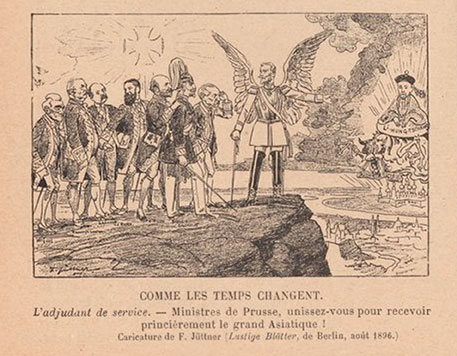
This image dates from 1896 and depicts Prussia (the winged figure) urging other countries to unite and capture Asia. See: https://visualizingcultures.mit.edu/boxer_uprising/gallery/pages/Grand-Carteret_34_Gelb28723.htm
Image 2:
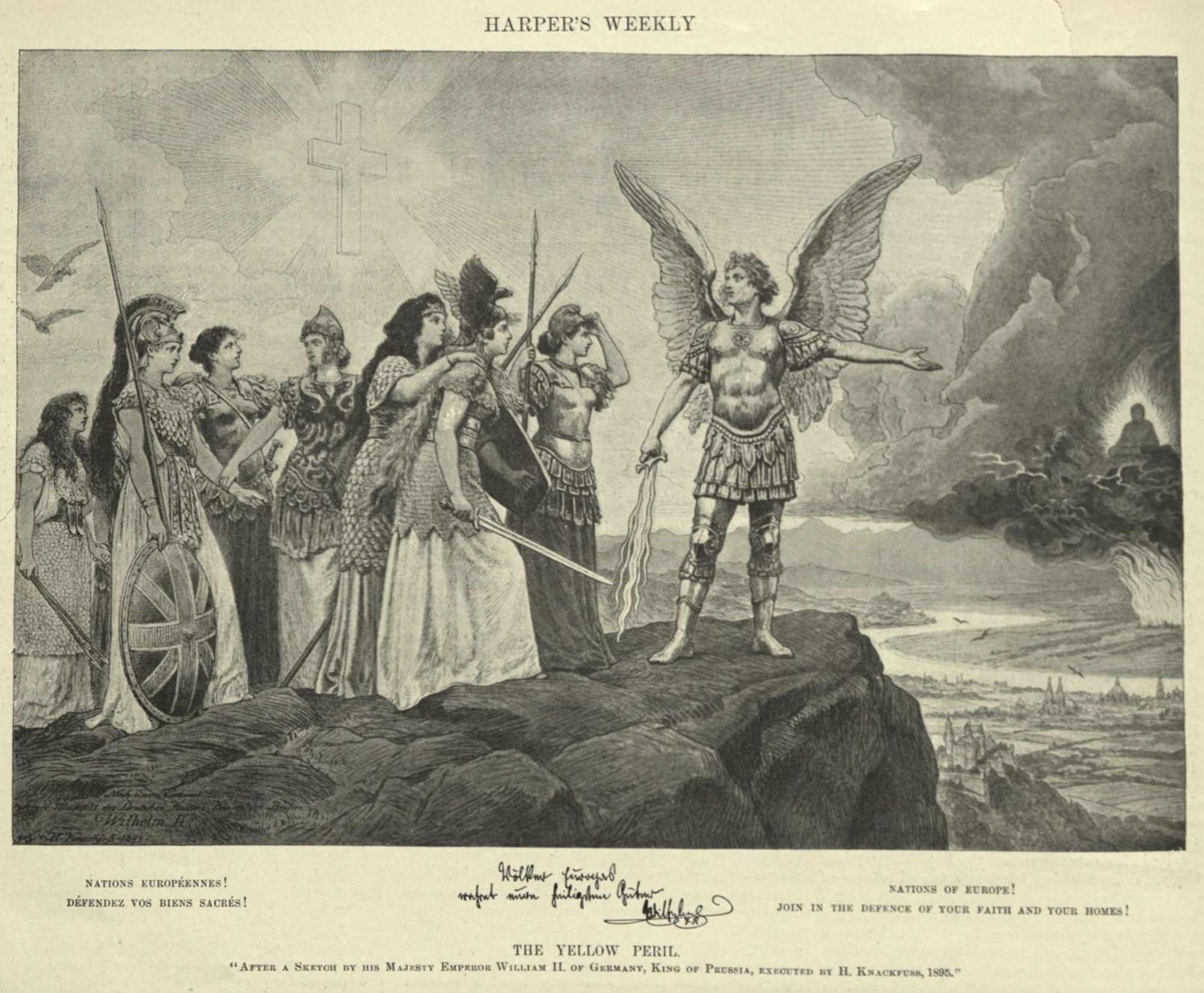
Harper's Weekly, January 22, 1898 (prior to the Boxer Rebellion): https://visualizingcultures.mit.edu/boxer_uprising/gallery/pages/1899_244_001_mailed_fi.htm See the image just above, which inspired this one.
Image 3:
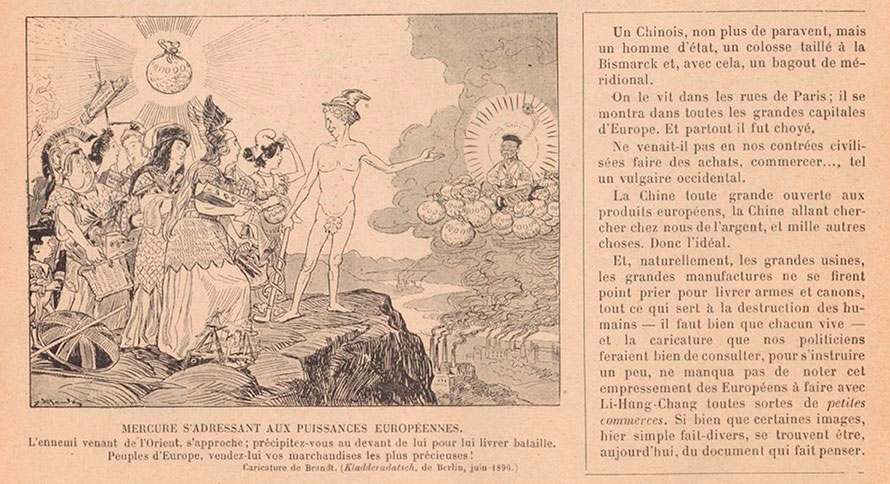
A French caricature where a winged Mercury addresses the European powers (1895). See: https://visualizingcultures.mit.edu/boxer_uprising/gallery/pages/Grand-Carteret_22b_LIH.htm
Image 4:
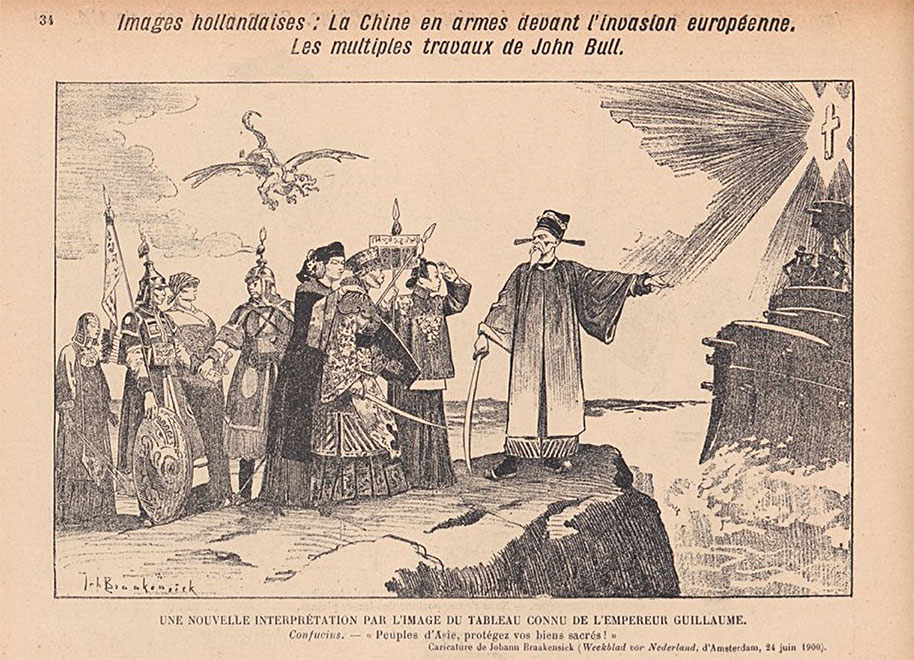
Another variation from Grand-Carteret (1900) by an artist from Amsterdam, Holland (which had had an extensive trading empire built on trade with Asia, but not at the time this was sketched). See: https://visualizingcultures.mit.edu/boxer_uprising/gallery/pages/Grand-Carteret_36_DRAG.htm
Image 5:
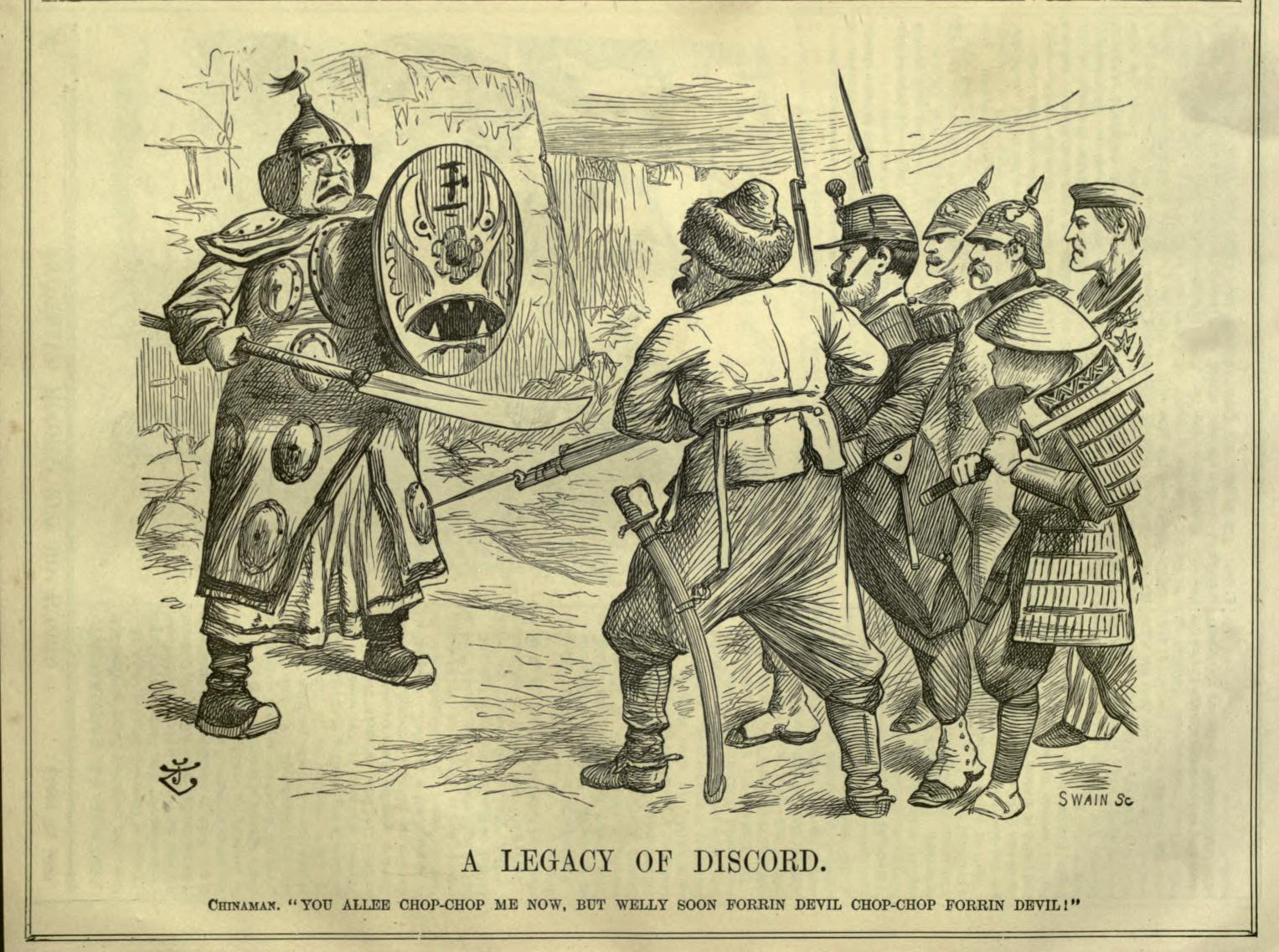
From the British magazine Punch (1900). See https://visualizingcultures.mit.edu/boxer_uprising/gallery/pages/1900_punchvol118a119B.htm
Image 6:
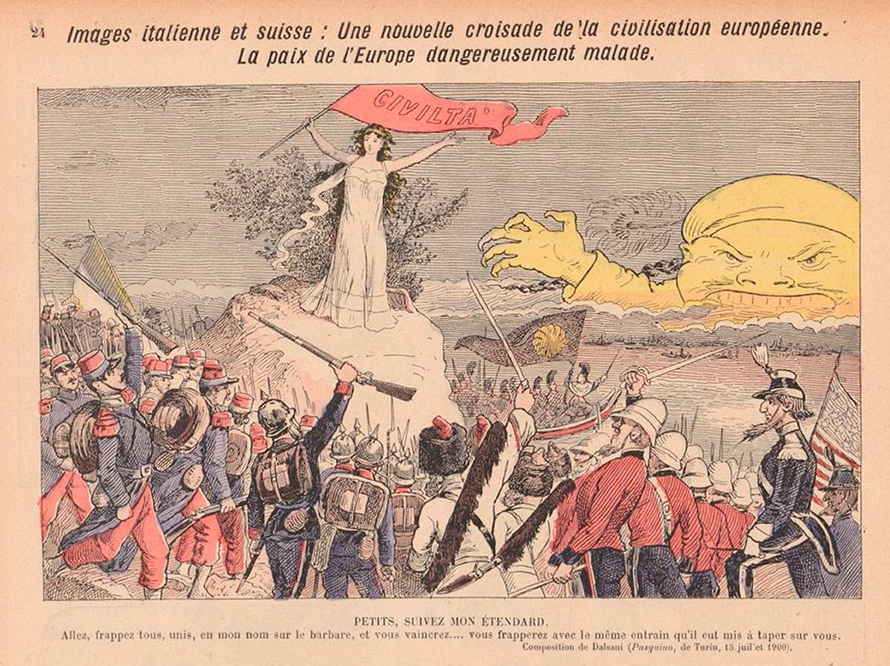
From the French publication, Grand-Carteret, 1900. See: https://visualizingcultures.mit.edu/boxer_uprising/gallery/pages/Grand-Carteret_38a_YEL.htm
Image 7:
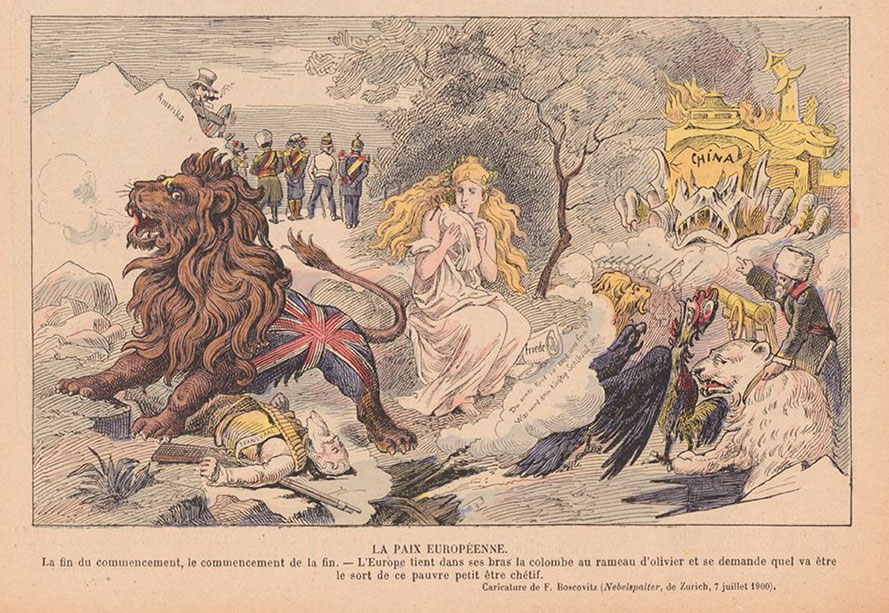
From the French publication, Grand-Carteret (1900). See: https://visualizingcultures.mit.edu/boxer_uprising/gallery/pages/Grand-Carteret_38b_YEL.htm
Image 8:
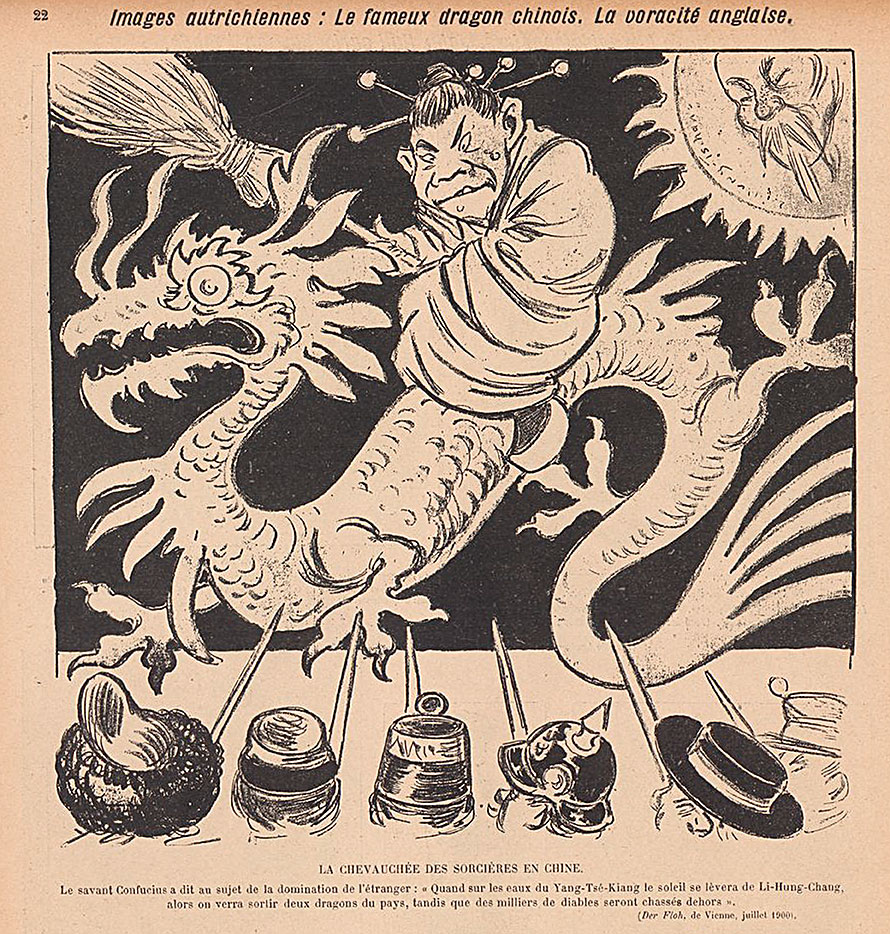
From the French publication, Grand-Carteret (1900). See: https://visualizingcultures.mit.edu/boxer_uprising/gallery/pages/Grand-Carteret_38a_YEL.htm
Image 9:

A poster of Protestant missionaries killed during the Boxer Rebellion. For a description of the individuals, see: https://www.phcmontreat.org/BoxerRebellion-Presbyterians.htm
Image 10:
.jpg?revision=1)
Execution of a Boxer rebel at the command of French occupying forces at Tientsin. From Gordon Casserly, The land of the boxers, or, China under the allies (London, 1903), Digitized by MSN from a copy at the Cornell University Library, courtesy of Wikimedia Commons. The photograph was followed in the volume by this text: "No race on earth is capable of such awful cruelty, such hellish devices of torture, as the Chinese. And the unfortunate missionaries, the luckless wounded soldiers who fell into their hands, experienced treatment before which the worst deviltries of the Red Indian seemed humane. Occasionally some of these fiends were captured by the Allies; often only the instruments, but sometimes the instigators of the terrible outrages on Europeans, the mandarins who had spurred on the maddened Boxers to their worst excesses. For these no fitting punishment could be devised, and a swift death was too kind. But in the latter days of the campaign too many suffered an unmerited fate. The blood heated by the tales of Chinese cruelty at the outbreak of the troubles did not cool rapidly. The murders of the missionaries and civil engineers, of the unhappy European women and children, could not be readily forgotten."
Fears and Images of Mongols reflected in Popular Culture and Russian film:
Normally, historians would not suggest reading Wikipedia articles, as their authors can range from experts in the field to the truly misinformed. However, these articles can serve as excellent indicators of popular culture and the war of ideas in a popularized format. They are often the first source of information individuals will encounter on a topic. Similarly, social media, films, television shows, and cartoons often reflect and shape popular perceptions on a topic or a particular group.
Read your assigned article from the list of following articles about the depictions of Mongol culture in films before class and be prepared to answer the following questions.
Questions to Consider:
How are Mongols being depicted in this film or television show? Be very specific.
Why are the Mongols being represented in the way they are?
What does this tell us about the agendas or biases of the film-maker?
Do you see elements of the "Yellow Peril" stereotype emerging in this film? If so, which ones?
If not, why not? What alternative representations of the Mongols emerge instead?
Mongol: The Rise of Genghis Khan (2007):
The Golden Horde (2019):
Furious (2017):
Genghis Khan (1965):
Marco Polo (Netflix):
The Conqueror (1956):
Flash Gordon and Ming the Merciless:
Representations of Modern Mongolian Culture:
In addition to the "Yellow Peril" stereotype, there are subtler forms of cultural voyeurism which often emerge in documentaries and travelogues produced about modern Mongolia. If time permits, students could watch and analyze one of the following documentaries. Or they could view short clips of representations of Mongolian culture produced by westerners, comparing and contrasting them with representations by Mongolian film-makers.
Longer Documentaries:
https://www.youtube.com/watch?v=HiUsj3yRfY4
https://www.youtube.com/watch?v=WBLqkjiEDcE
Shorter representations of Mongol Culture by Westerners:
https://www.youtube.com/watch?v=KMTzVaDRN-g
Mongolians Address Stereotypes and Speak About Their Culture:
https://www.youtube.com/watch?v=uxmSKTMFK0U
https://www.youtube.com/watch?v=I079tNQ_Q4E

